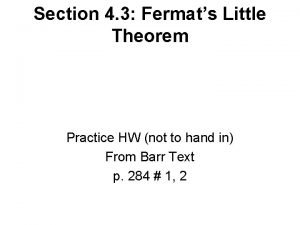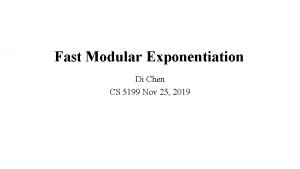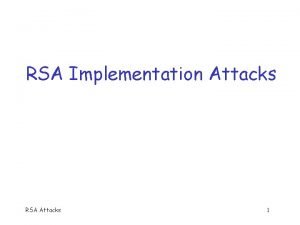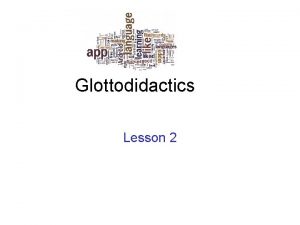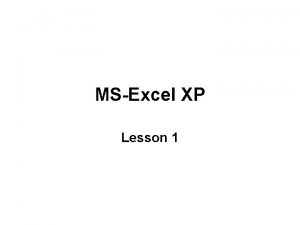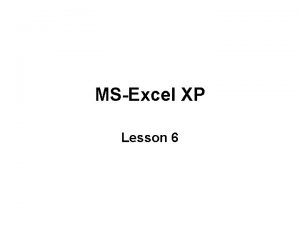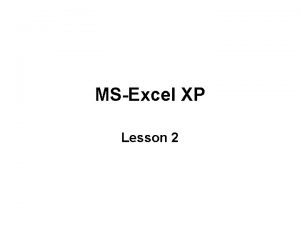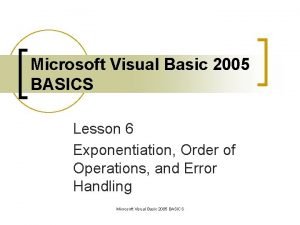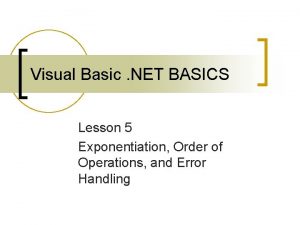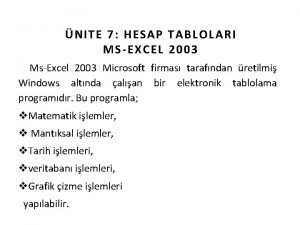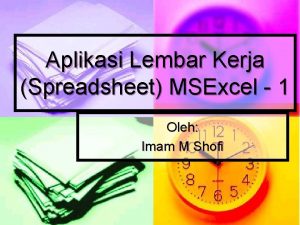MSExcel XP Lesson 5 Exponentiation 1 A 1


















- Slides: 18

MS-Excel XP Lesson 5

Exponentiation 1. A 1 2 A 2 3 A 3 =A 1^A 2 B 1 =2^4 2. ^ for exponentiation

ROUND Function 1. 2. Round a number to a specified number of digits. A 1 15. 4876 A 2 =ROUND(A 1, 3) A 3 =ROUND(A 1, 2) A 4 =ROUND(A 1, 1) A 5 =ROUND(A 1, 0) B 1 12. 5 B 2 =ROUND(B 1, 0) B 3 13. 5 B 4 =ROUND(B 3, 0) B 5 =ROUND(12. 875, 2) B 6 =ROUND(12. 865, 2)

ROUND Function 1. 2. 3. 4. Insert menu, Function menu item, Select category as Math & Trig Select ROUND function and click ok Select values to num and num_digits fields 5. Click ok =ROUND(AVERAGE(A 1: A 5), 0)

INT Function 1. Rounds a number down to the nearest integer. 2. A 1 12. 25 A 2 =INT(A 1) A 3 =INT(12. 45) A 4 =INT(13. 689) 3. Insert menu, Function menu item, 4. Select category as Math & Trig 5. Select INT function and click ok 6. Select value to number field 7. Click ok

MOD Function 1. Returns the remainder after a number is divided by a divisor. 2. A 1 10 A 2 3 A 3 =MOD(A 1, A 2) A 4 =MOD(5, 2) A 5 =MOD(3, 4) A 6 =MOD(4, 3) 3. Insert menu, Function menu item, 4. Select category as Math & Trig 5. Select MOD function and click ok 6. Select values to number and divisor fields 7. Click ok

IF Function 1. 3. 4. 5. 6. 7. 8. Checks whether a condition is met, and returns one value if TRUE, and another value if FALSE. =IF(CONDITION, TRUE Value, FALSE Value) A 1 45 A 2 50 A 3 65 B 1 =IF(A 1>=50, ”PASS”, “FAIL”) B 2 to B 3 drag formula in B 1 = equals to <> not equals to < less than > greater than <= less than or equals to >= greater than or equals to

IF Function 1. 2. 3. 4. Insert menu, Function menu item Select category as Logical Select IF function and click ok Select values to logical_test, value_if_true and value_if_false fileds 5. Click ok

Nested IF Functions 1. A 1 MARKS A 2 40 A 3 50 A 4 60 A 5 70 A 6 80 A 7 90 B 1 GRADE B 2 =IF(A 2>=75, ”A”, IF(A 2>=65, ”B”, IF(A 2>=55, ”C”, IF(A 2>=55, ”S”, ”F”)))) B 3 to B 7 drag formula in B 2

Nested IF Functions 1. A 1 MARKS A 2 40 A 3 50 A 4 60 A 5 70 A 6 80 A 7 90 B 1 GRADE B 2 =IF(A 2<45, ”F”, IF(A 2<55, ”S”, IF(A 2<65, ”C”, IF(A 2<75, ”B”, ”A”)))) B 3 to B 7 drag formula in B 2

TODAY Function 1. 2. 3. 4. Returns the current date formatted as a date. A 1 =TODAY() A 2 Select Insert menu Select Function menu item Select category as Date & Time Select TODAY function Click ok You can formatting date in a cell using format cells option

DATE Function 1. 2. 3. Returns the number that represents the date in MSExcel date-time code. =DATE(Year, Month, Day) A 1 =DATE(2006, 6, 12) A 2 =DATE(1979, 11, 7) A 3 Select insert menu and function menu item Select category as Date & Time Select DATE function and click ok Select values to year, month, day fields Click ok

DAY Function 1. 2. Returns the day of the month, a number from 1 to 31 A 1 =DAY(TODAY()) A 2 =DAY(DATE(1979, 11, 7)) A 3 =DATE(1980, 10, 30) A 4 Select insert menu and function menu item Select category as Date & Time Select DAY function and click ok Select value (A 3) to serial_no field Click ok

MONTH Function 1. 2. Returns the month, a number from 1(January) to 12 (December) A 1 =MONTH(TODAY()) A 2 =MONTH (DATE(1979, 11, 7)) A 3 =DATE(1980, 10, 30) A 4 Select insert menu and function menu item Select category as Date & Time Select MONTH function and click ok Select value (A 3) to serial_no field Click ok

YEAR Function 1. 2. Returns the year of a date, an integer in the range 1900 to 9999 A 1 =YEAR(TODAY()) A 2 =YEAR (DATE(1979, 11, 7)) A 3 =DATE(1980, 10, 30) A 4 Select insert menu and function menu item Select category as Date & Time Select YEAR function and click ok Select value (A 3) to serial_no field Click ok

WEEKDAY Function 1. 2. Returns a number from 1 to 7, identifying the day of the week of a date A 1 =WEEKDAY(TODAY(), 1) 1=Sunday B 1 =WEEKDAY(TODAY(), 2) 1=Monday A 2 =WEEKDAY (DATE(1979, 11, 7), 1) B 2 =WEEKDAY (DATE(1979, 11, 7), 2) A 3 =DATE(1980, 10, 30) A 4 Select insert menu and function menu item Select category as Date & Time Select WEEKDAY function and click ok Select values (A 3) to serial_no field and 1 or 2 to return_type field Click ok

WEEKDAY Function Return type = 1 1=Sunday, 2: =Monday, …, 7=Saturday Return type = 2 1=Monday, 2=Tuesday, …………. . , 7=Sunday

NOW Function 1. 2. 3. 4. Returns the current date and time formatted as a date and time. A 1 =NOW() A 2 Select Insert menu Select Function menu item Select category as Date & Time Select NOW function Click ok You can formatting time in a cell using format cells option
 Déchiffrement
Déchiffrement Fermat's little theorem practice problems
Fermat's little theorem practice problems Fast modular exponentiation python
Fast modular exponentiation python Horner's rule and binary exponentiation
Horner's rule and binary exponentiation Modular exponentiation
Modular exponentiation Modular exponentiation
Modular exponentiation Lesson outline lesson 3 describing circuits answers
Lesson outline lesson 3 describing circuits answers Mountain building
Mountain building Lesson outline lesson 2 aquatic ecosystems answer key
Lesson outline lesson 2 aquatic ecosystems answer key Mikro planners of assessment (educator)
Mikro planners of assessment (educator) L101 introduction to healthcare leadership
L101 introduction to healthcare leadership Ravi poured the milk for the kitchen
Ravi poured the milk for the kitchen Chapter 1 lesson 1 your total health lesson 1 quiz
Chapter 1 lesson 1 your total health lesson 1 quiz Weather forecasts lesson 3 outline answers
Weather forecasts lesson 3 outline answers Sat vocabulary lesson and practice lesson 4
Sat vocabulary lesson and practice lesson 4 Physical properties lesson 2
Physical properties lesson 2 The science duo physical and chemical changes
The science duo physical and chemical changes Lesson outline lesson 1 climates of earth answers key
Lesson outline lesson 1 climates of earth answers key Glottodidactics
Glottodidactics

